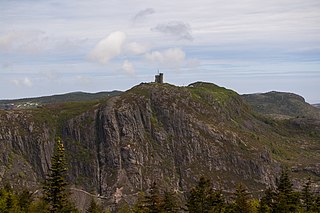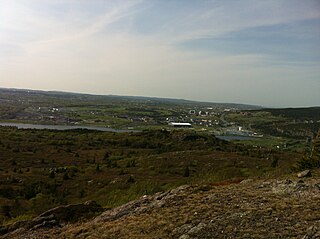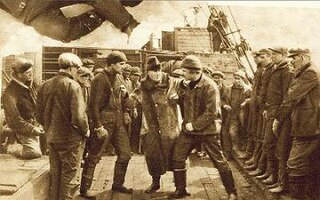
The Newfoundland and Labrador New Democratic Party is a social democratic political party in Newfoundland and Labrador, Canada. It is a provincial section of the federal New Democratic Party. It was formed in 1961 as the successor to the Co-operative Commonwealth Federation (CCF) and the Newfoundland Democratic Party. The party first contested the 1962 provincial election. The party won its first seat in the House of Assembly in 1984 and has been represented in the legislature since 1990.

St. John's South—Mount Pearl is a federal electoral district in Newfoundland and Labrador, Canada, that has been represented in the House of Commons of Canada since 2004.

Signal Hill is a hill which overlooks the harbour and city of St. John's, Newfoundland and Labrador, Canada. The majority of Signal Hill, including Cabot Tower, is designated a National Historic Site. The highest point, Ladies' Lookout, is 167 m (548 ft) high.

Signal Hill-Quidi Vidi is a former provincial electoral district for the House of Assembly of Newfoundland and Labrador, Canada. As of 2011 there were 8,137 eligible voters living within the district.

St. John's East was a provincial electoral district for the House of Assembly of Newfoundland and Labrador, Canada. In 2011 there were 8,063 eligible voters living within the district. The district was abolished in 2015 as Newfoundland and Labrador reduced the number of districts. Portions of the district are now within the district of St. John's East-Quidi Vidi.

Lewis Varick Frissell was an American documentary filmmaker. His last film, The Viking, set in Newfoundland, involved the largest loss of life of a film production crew in history. This film was also "the first film to record sound and dialogue on location".

The Grand Concourse is an integrated walkway and green space network connecting 10 municipalities in the Province of Newfoundland and Labrador. It has over 200 kilometers (120 mi) of walkways linking every major park, river, pond, and green space in the Northeast Avalon region. The Grand Concourse is managed by the Grand Concourse Authority, a non-profit organization with a board of directors made up of representatives from a variety of community-based and government groups.
Garrison St. John's, formerly known as and commonly referred to as CFS St. John's, is a Canadian Forces Garrison in St. John's, Newfoundland and Labrador.

Lorraine Michael is a social-democratic Canadian politician from Newfoundland and Labrador, Canada. From May 2006 until March 2015, Michael was the leader of the Newfoundland and Labrador New Democratic Party (NDP). She is a former nun, teacher, and social activist.
John L. Noseworthy is a Canadian accountant and politician who served as Auditor General of Newfoundland and Labrador from April 25, 2002, till July 30, 2011. Noseworthy was the Progressive Conservative Party of Newfoundland and Labrador candidate for the district of Signal Hill-Quidi Vidi in the October 2011 provincial election losing to New Democratic Party candidate Lorraine Michael.

Quidi Vidi Brewing Company is a craft brewery in Quidi Vidi village, a neighbourhood of St. John's, Newfoundland and Labrador, Canada.
Patricia "Bonnie" Hickey is a Canadian former politician. Hickey was a member of the House of Commons of Canada from 1993 to 1997.

The East Coast Trail (ECT) is a long-distance coastal footpath located in the Canadian province of Newfoundland and Labrador. It is a developed trail over 336 kilometres (209 mi) long, creation of which began in 1994. It is made up of 25 linked wilderness paths and passes through more than 30 communities. It was named one of the best adventure destinations by National Geographic in 2012 and is extended and improved yearly.

The neighbourhood of Pleasantville in St. John's, Newfoundland and Labrador is located in the east end of the city, directly north of the downtown. The neighbourhood extends from the north side of Quidi Vidi Lake northward to Newfoundland Drive, and is largely made up of apartment blocks.
The architecture of St. John's, in Newfoundland and Labrador, Canada, has a style distinct from that of the rest of Canada, and its major buildings are remnants of its history and prestige as the first British colonial capital. The city of St. John's has had a long history, with inhabitation dating to the 16th century onwards. As the city grew, so, too, did the landscape. Buildings took a variety of styles according to the styles and means available to build the structures. Starting as a fishing outpost for European fishermen, St. John's consisted mostly of the homes of fishermen, sheds, storage shacks, and wharves. Of course, these structures were small and constructed out of wood. Like many other cities of the time, as the Industrial Revolution took hold and new methods and materials for construction were introduced, the landscape changed as the city grew in width and height. The Great Fire of 1892 destroyed most of the downtown core, and most residential and other wood-frame buildings date from this period. Often compared to San Francisco because of its hilly terrain and steep maze of residential streets, housing in St. John's is typically painted in bright colours, unlike most other parts of Canada.

The Viking, also known as White Thunder and Vikings of the Ice Field, is a 1931 Newfoundland/American adventure film about sealing directed by George Melford. The Viking was the first film to record sound and dialogue on location with the use of magnetic wire recording. It is best known for the explosion aboard the ship SS Viking during filming, in which many members of the crew, including producer Varick Frissell, were killed. It remains the incident with the largest loss of life in film history.

Fort William was a fort in St. John's built in 1698 to protect English interests on Newfoundland, primarily against French opposition. It was the original headquarters of the British garrison in Newfoundland. A second fort, known as Fort George was situated at the east end of the harbour connected by a subterranean passage with Fort William. On the south side of the Narrows, there was a third fortification called the Castle. Garrison headquarters were later moved to Fort Townshend, which was built between 1775-1779.

Mallard Cottage is a heritage-designated building located within Quidi Vidi Village in the City of St.John's, Newfoundland and Labrador. The cottage is a one-and-a-half-stories with a hipped roof and central chimney. The architecture is an example of early 19th century vernacular style patterned on Irish thatched-roofed cottages. Though the exact date of construction cannot be confirmed, based on evidence from construction techniques, architectural style, and oral history the date for its construction are placed between 1820 and 1840, making it one of the oldest residential structures in St. John's. Two other buildings in St.John's of the same style are Anderson House, built 1804–1805, and Martin McNamara House, exact construction date unknown. These three structures are the best preserved examples of late 18th and early 19th century architecture in St.John's.
The 2022 royal tour of Canada by Charles, Prince of Wales and Camilla, Duchess of Cornwall, took place from 17 to 19 May 2022, as part of the Canadian celebrations of the Queen's Platinum Jubilee. During the three-day tour, the couple visited communities throughout Newfoundland and Labrador, the National Capital Region, and the Northwest Territories. Also, the tour had a special focus on reconciliation with Indigenous peoples, which the Prince framed as a "vital process".

















